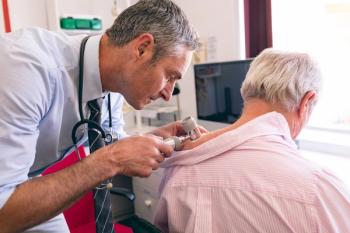
The American Journal of Managed Care
- June 2025
- Volume 31
- Issue 6
- Pages: 296-300
Impact of COVID-19 on Specialty Televisits in a Large Integrated Health Care System
Key Takeaways
Specialty televisits remain common in the Veterans Health Administration following the COVID-19 pandemic, suggesting they will remain an important ongoing care modality for many patients.
ABSTRACT
Objectives: The COVID-19 pandemic stimulated an unprecedented expansion in use of video and telephone visits (televisits) for routine specialty care as a substitute for in-person clinic visits. However, the sustainability of televisit use for specialty care delivery following the pandemic is unclear.
Study Design/Methods: In this descriptive, retrospective study of national Veterans Health Administration (VHA) data, we assessed total outpatient visit volume by month in 9 specialties (cardiology, dermatology, eye care, gastroenterology [GI]/hepatology, neurosurgery, orthopedics, podiatry, substance use disorder [SUD], and urology) at all VHA facilities in the US between January 2019 (pre–COVID-19) and September 2023 (representing late phases of health system recovery post COVID-19). We also categorized outpatient visits by modality (in person, telephone, video) and assessed time trends in the proportion of total outpatient visits in each specialty delivered by televisit. Descriptive statistics were used to summarize the study findings.
Results: Although total visit volumes in most VHA specialties had returned to pre–COVID-19 baselines by the end of the study period, they did not fully rebound in others, suggesting persistent care gaps. Televisit use increased from a mean of 7% in quarter 1 (Q1) 2019 to 54% in Q2 2020, then decreased modestly to 27% of all specialty visits by Q3 2023. The specialties with the highest sustained televisit use in Q3 2023 were SUD and GI, despite restored in-person visit availability. The use of telephone visits exceeded the use of video visits throughout the study period.
Conclusions: Our findings suggest that televisits will likely remain an important visit modality for patients in the postpandemic era.
Am J Manag Care. 2025;31(6):296-300.
Takeaway Points
Significant differences exist in the uptake and sustained use of specialty televisits in the Veterans Health Administration (VHA).
- Although total visit volumes in most VHA specialty areas have returned to pre–COVID-19 baselines nationally, they have not fully rebounded in others, suggesting persistent care gaps in some specialties.
- Televisit use in most specialties has remained elevated in the COVID-19 recovery period despite restored access to in-person care, suggesting televisits will remain an important visit modality for many patients.
- Despite substantial VHA investment in infrastructure to conduct video visits, most televisits were conducted by telephone before and after the pandemic.
The COVID-19 pandemic caused widespread disruptions in the US health care system that fundamentally altered how outpatient care is delivered across specialties and practice settings. Among the most significant changes has been the unprecedented expanded use of telehealth modalities, such as e-consults,1 remote patient monitoring,2 and televisits (outpatient provider-to-patient clinic encounters occurring by video or telephone rather than in person).3,4 Although prior studies have examined changes in televisit use in the wake of the COVID-19 pandemic, these studies have primarily been limited to earlier periods of the pandemic5-10 and/or lack granularity in data to examine variation in televisit use across specialties.11,12
Understanding variation in televisit use in distinct specialties, and the extent to which the increased adoption of televisits that was initially stimulated out of necessity during the pandemic has persisted, is crucial to understanding the sustainability of specialty televisit use in the postpandemic era and informing future televisit reimbursement policies and research. As the largest integrated health care delivery system in the US, the Veterans Health Administration (VHA) is a unique environment in which to examine how televisit use for outpatient specialty care changed nationally in the late phases of the pandemic, given its rich administrative data sets, well-documented and long-standing investment in telehealth infrastructure,13,14 and focus on optimizing specialty care access.3,15 Moreover, in contrast to practice patterns in fee-for-service systems, televisit use in integrated systems such as the VHA is less likely to be influenced by economic incentives,16 providing a unique opportunity to deduce broader patterns in televisit use independent of such factors. The VHA used a 4-phase approach to the COVID-19 pandemic leveraging technology to provide most outpatient care for veterans through telehealth services, utilizing various triage systems to continue in-person services as appropriate at the peak of the pandemic, and prioritizing recovery processes to support return to normal operations after the public health emergency had passed.17,18
Lessons learned by the VHA are increasingly relevant to other health care systems because issues confronting the VHA, including the need to provide timely access, coordination of care, and consistently high-quality care across a diverse system, mirror those of the larger US health care system.19 In this descriptive study, we aimed to characterize longitudinal trends in the use of televisit-delivered outpatient specialty care within the VHA and understand whether and how patterns of specialty televisit utilization have changed as we enter a postpandemic era.
METHODS
This was a retrospective study using VHA administrative data on all outpatient encounters at VHA facilities nationally in 9 medical and surgical specialties from January 2019 to September 2023. These encounters were identified through the VHA Corporate Data Warehouse, a data repository that tracks data for an open cohort of the approximately 9 million veterans enrolled in VHA services.11,20 The 9 specialties, representing diverse patient populations, volumes, and practice characteristics, were cardiology, dermatology, eye care, gastroenterology (GI)/hepatology, neurosurgery, orthopedics, podiatry, substance use disorder (SUD), and urology. Our study period was designed to capture changes in televisit use for specialty care at baseline (prepandemic) and during early and late phases of the COVID-19 pandemic, which officially ended in May 2023.11
Nonprocedural clinic encounters were identified and categorized by modality (in person, telephone, video) via the presence or absence of specific Current Procedural Terminology (CPT), CPT modifier, and clinic stop codes. Video visits were identified in 3 ways by the presence of: (1) CPT codes 99421, 99422, or 99423 (non–face-to-face or online digital evaluation/management codes); (2) CPT modifier codes GT (interactive audio/video telecommunications systems) or 95 (synchronous telemedicine service rendered via real-time interactive audio/video telecommunications system); or (3) paired secondary stop codes on the same date denoting patient- and provider-site video encounters (provider site: 179, 648, 645, 679, 692, or 693; patient site: 644 or 690). Telephone visits were identified by the presence of: (1) CPT code 99441, 99442, or 99443 (telephone evaluation/management) or (2) primary stop code 324 (telephone medicine). Any visit not meeting video or telephone visit criteria was categorized as an in-person visit. Visits with secondary stop codes associated with emergency care, endoscopy, medical/surgical day unit, compensation/pension exam, or research were excluded.
Quarterly trends in total outpatient visits and the proportion of televisits to total visits were examined for each specialty. Televisits were then further categorized by visit modality. Descriptive statistics were used to summarize and analyze the data, providing insights into the patterns, trends, and characteristics of televisit use for outpatient specialty care in the VHA.
RESULTS
There were 58,723,897 VHA outpatient visits across the 9 specialties at VHA facilities nationally during the study period. Quarterly trends in VHA total outpatient visit volume (any modality) in the 9 specialties are reported in
Quarterly outpatient visit volumes and the proportion of televisits by specialty across the study period are shown in the eAppendix (
Quarterly trends in VHA outpatient visits by specialty and modality (in person, telephone, video) are shown in
DISCUSSION
We sought to better characterize trends in specialty outpatient visits, including televisits and traditional in-person visits, over the course of the COVID-19 pandemic in a large, national, integrated health care system with a particular focus on the sustainability of televisit use as the pandemic waned. Although the VHA serves a unique patient population, nationwide trends in televisit use in the VHA provide important insights regarding the ongoing appetite for televisit use among a broader patient population that are also relevant to non-VHA health care systems confronted with the need to provide timely access and care coordination.
Our results show that although visit volumes in many specialties had returned to pre–COVID-19 baseline levels by Q3 2023, some (notably, SUD and cardiology) had not fully recovered, suggesting persistent gaps in care. Additionally, televisit use expanded in the VHA across specialties in the early months of the pandemic, peaked in Q2 2022, and remained elevated compared to pre–COVID-19 baselines as the pandemic waned, despite restored in-person access. However, the extent to which televisits were utilized across specialties varied widely—podiatry and eye care had the lowest televisit uptake, and SUD had the highest televisit uptake. Interestingly, we found a high proportion of telephone visits across the study period despite substantial VHA investment in infrastructure needed to conduct video visits.3 The reasons for this are unclear, but it may be due to ongoing challenges with adequate connectivity/technology or simply patient preference for telephone-based visits due to convenience or reasons unrelated to connectivity/technology.
Although other studies have examined pandemic-era trends in specialty televisit use, these studies largely focused on earlier stages of the pandemic that may be less representative of longer-term trends,5-10 assessed visits at a single center rather than incorporating national data,7,10,21 and/or examined aggregate data of outpatient specialty televisit utilization instead of examining variation in patterns of utilization in different specialties.11 A recent study of in-person, video-based, and telephone-based care in the VHA evaluated more recent trends in televisit use through July 2023 but compared primary care, mental health, and subspecialty care in aggregate rather than examining variation in utilization of televisit modalities among different specialties as we did in our study.11 In another study assessing televisit use before and during the pandemic (January 2020-December 2020) in a large, integrated health system on the West Coast, there was a rapid drop-off of in-person visits and an increase in televisits in the initial weeks of pandemic-related lockdowns, but in-person visit volumes rebounded and televisits stabilized at approximately 20% of total visits by December 2020.22 Notably, this study did not distinguish between primary care and specialty care visit volumes, nor did it evaluate televisit use in later phases of the pandemic, as was the focus of our study. The few studies that have examined variation in televisit use among different specialties also focused on earlier phases of the pandemic. In a single-center study of televisit use in orthopedics, dermatology, cardiology, endocrinology, psychiatry, and nonurgent primary care in a large academic hospital system (July 2019-early October 2020), investigators found that televisit adoption varied widely by specialty.3 Unlike less-procedural specialties (eg, endocrinology), procedural specialties (eg, cardiology) had less uptake of televisits during the acute phase of the pandemic and largely had reverted to prepandemic in-person visit volumes by fall 2020, which is consistent with findings in our study. The explanation for varied uptake of televisits across specialties is likely multifactorial. Potential considerations include the unique clinical practice characteristics of each specialty (eg, importance of physical exam, acuity of clinical problems, balance of cognitive/procedural aspects), implementation challenges (eg, investment in appropriate telehealth infrastructure, leadership buy-in), differences in patient preferences and characteristics associated with televisit use, and differences in economic incentives for telehealth.23,24 Explanations for the marked expansion in and sustained adoption of televisit use for SUD (classified in the VHA as specialty care but broadly understood to be a form of mental health care) may include the presence of existing telehealth infrastructure and earlier efforts to promote telemental health care in the VHA prior to the pandemic and that mental health services (eg, therapy/counseling, medication management, psychoeducation) may be more amenable to substitution with televisits than some other forms of medical care.12
Limitations
This study has several limitations. First, given the use of administrative data, there was risk of misclassification of visit modalities. However, we used several methods to identify televisit encounters to minimize this risk. Second, although we selected 9 specialties to represent a diversity of patient populations, volume, and practice characteristics, generalizability to other specialties not specifically evaluated in this study may be limited. Third, total visit volumes may have been affected by death rates during the pandemic; one study reported 52,038 excess veteran deaths from March 2020 to December 2020 (16.8% excess mortality), although a majority of VHA facilities experienced lower rates of excess mortality than the 22.9% estimated for the US as a whole.25 Fourth, our focus on VHA televisit use may limit generalizability of our findings to other health systems/practices with different reimbursement systems and patient populations. However, studying this question in the context of the VHA provides important insights regarding continued use of televisits that are important for insurers and other stakeholders to understand in considering longitudinal investment in access to televisits in non-VHA health systems. Moreover, by examining all outpatient specialty care encounters at VHA facilities in the US, we were able to study shifts in trends and characteristics of specialty care access for veterans nationally. Finally, although our analysis extended to September 2023, months after the official end of the federal COVID-19 public health emergency declaration in May 2023,11 the pandemic’s effects may still have influenced patients’ overall care-seeking behavior and televisit use. Despite these limitations, our study makes important contributions to existing literature by providing insight into the postpandemic future of televisit use for specialty care delivery, particularly in an integrated health system such as the VHA.
CONCLUSION
Our findings suggest that televisits are likely to remain an important visit modality for many patients, particularly in some specialties. Indeed, growing evidence supports the role of televisits within specialty care and patient/provider satisfaction with televisits.22,26-29 Understanding the intended and unintended impacts of COVID-19–related expansion of specialty televisit use on patient-centered outcomes, defining clinically appropriate use of televisits (and different televisit modalities), and elucidating potential barriers to equitable televisit access will be important topics for future research.
Author Affiliations: Division of Gastroenterology and Hepatology, Michigan Medicine, University of Michigan (JJK, LAL, SDS, MAA), Ann Arbor, MI; Veterans Affairs Center for Clinical Management Research, VA Ann Arbor Healthcare System (RGH, LAL, SDS, MAA), Ann Arbor, MI; Department of Psychiatry, Michigan Medicine, University of Michigan (LAL), Ann Arbor, MI; Institute for Healthcare Policy and Innovation, University of Michigan (JJK, LAL, SDS, MAA), Ann Arbor, MI.
Source of Funding: This study was supported by funding from the VA Office of Connected Care (OCC 21-11) awarded to Dr Adams and Dr Lin. Dr Lin was also supported by a Veterans Affairs Health Services Research & Development Career Development Award (CDA 18-008) during this study.
Author Disclosures: The authors report no relationship or financial interest with any entity that would pose a conflict of interest with the subject matter of this article.
Authorship Information: Concept and design (JJK, LAL, SDS, MAA); acquisition of data (RGH, MAA); analysis and interpretation of data (JJK, RGH, MAA); drafting of the manuscript (JJK); critical revision of the manuscript for important intellectual content (JJK, LAL, SDS, MAA); statistical analysis (JJK, RGH, MAA); obtaining funding (MAA); and supervision (LAL, SDS, MAA).
Address Correspondence to: Joyce J. Kim, MD, University of Michigan Division of Gastroenterology, 1500 E Medical Center Dr, Ann Arbor, MI 48109. Email: kjuhee@med.umich.edu.
REFERENCES
1. Leyton C, Zhang C, Rikin S. Evaluation of the effects of the COVID-19 pandemic on electronic consultation use in primary care. Telemed J E Health. 2022;28(1):66-72. doi:10.1089/tmj.2020.0547
2. Casale PN, Vyavahare M, Coyne S, et al. The promise of remote patient monitoring: lessons learned during the COVID-19 surge in New York City. Am J Med Qual. 2021;36(3):139-144. doi:10.1097/01.JMQ.0000741968.61211.2b
3. Ferguson JM, Jacobs J, Yefimova M, Greene L, Heyworth L, Zulman DM. Virtual care expansion in the Veterans Health Administration during the COVID-19 pandemic: clinical services and patient characteristics associated with utilization. J Am Med Inform Assoc. 2021;28(3):453-462. doi:10.1093/jamia/ocaa284
4. Verma S. Early impact of CMS expansion of Medicare telehealth during COVID-19. Health Affairs. July 15, 2020. Accessed October 20, 2024.
5. Dunwoodie L, Tiwari V. Telemedicine use for oncology clinic visits at a large medical center during the onset of COVID-19. Telemed J E Health. 2023;29(8):1186-1194. doi:10.1089/tmj.2022.0294
6. Drake C, Lian T, Cameron B, Medynskaya K, Bosworth HB, Shah K. Understanding telemedicine’s “new normal”: variations in telemedicine use by specialty line and patient demographics. Telemed J E Health. 2022;28(1):51-59. doi:10.1089/tmj.2021.0041
7. Eberly LA, Kallan MJ, Julien HM, et al. Patient characteristics associated with telemedicine access for primary and specialty ambulatory care during the COVID-19 pandemic. JAMA Netw Open. 2020;3(12):e2031640. doi:10.1001/jamanetworkopen.2020.31640
8. Hsiao V, Chandereng T, Huebner JA, et al. Telemedicine use across medical specialties and diagnoses. Appl Clin Inform. 2023;14(1):172-184. doi:10.1055/s-0043-1762595
9. Ferguson JM, Wray CM, Jacobs J, et al. Variation in initial and continued use of primary, mental health, and specialty video care among veterans. Health Serv Res. 2023;58(2):402-414. doi:10.1111/1475-6773.14098
10. Balut MD, Wyte-Lake T, Steers WN, et al. Expansion of telemedicine during COVID-19 at a VA specialty clinic. Healthc (Amst). 2022;10(1):100599. doi:10.1016/j.hjdsi.2021.100599
11. Ferguson JM, Wray CM, Van Campen J, Zulman DM. A new equilibrium for telemedicine: prevalence of in-person, video-based, and telephone-based care in the Veterans Health Administration, 2019-2023. Ann Intern Med. 2024;177(2):262-264. doi:10.7326/M23-2644
12. Lum J, Sadej I, Pizer SD, Yee C. Telehealth access and substitution in the VHA. J Gen Intern Med. 2024;39(suppl 1):44-52. doi:10.1007/s11606-023-08465-0
13. Dhanani Z, Ferguson JM, Van Campen J, et al. Overcoming access barriers for veterans: cohort study of the distribution and use of Veterans Affairs’ video-enabled tablets before and during the COVID-19 pandemic. J Med Internet Res. 2023;25:e42563. doi:10.2196/42563
14. Myers US, Birks A, Grubaugh AL, Axon RN. Flattening the curve by getting ahead of it: how the VA healthcare system is leveraging telehealth to provide continued access to care for rural veterans. J Rural Health. 2021;37(1):194-196. doi:10.1111/jrh.12449
15. Lewinski AA, Sullivan C, Allen KD, et al. Accelerating implementation of virtual care in an integrated health care system: future research and operations priorities. J Gen Intern Med. 2021;36(8):2434-2442. doi:10.1007/s11606-020-06517-3
16. Lehner L, Burgess J, Hults D, Stefos T. Data and information requirements for the Department of Veterans Affairs resource allocation systems. Med Care. 1996;34(suppl 3):MS21-MS30. doi:10.1097/00005650-199603001-00003
17. Veterans Health Administration – Office of Emergency Management COVID-19 Response Plan: Incident-Specific Annex to the VHA High Consequence Infection (HCI) Base Plan. US Department of Veterans Affairs. March 23, 2020. Accessed October 20, 2024.
18. McDonough D. How VA served veterans during the pandemic. US Department of Veterans Affairs. May 23, 2023. Accessed October 20, 2024.
19. Atkins D, Kilbourne AM, Shulkin D. Moving from discovery to system-wide change: the role of research in a learning health care system: experience from three decades of health systems research in the Veterans Health Administration. Annu Rev Public Health. 2017;38:467-487. doi:10.1146/annurev-publhealth-031816-044255
20. Price LE, Shea K, Gephart S. The Veterans Affairs’s Corporate Data Warehouse: uses and implications for nursing research and practice. Nurs Adm Q. 2015;39(4):311-318. doi:10.1097/NAQ.0000000000000118
21. Franciosi EB, Tan AJ, Kassamali B, et al. The impact of telehealth implementation on underserved populations and no-show rates by medical specialty during the COVID-19 pandemic. Telemed J E Health. 2021;27(8):874-880. doi:10.1089/tmj.2020.0525
22. Hays RD, Skootsky SA. Patient experience with in-person and telehealth visits before and during the COVID-19 pandemic at a large integrated health system in the United States. J Gen Intern Med. 2022;37(4):847-852. doi:10.1007/s11606-021-07196-4
23. Connolly SL, Stolzmann KL, Heyworth L, Weaver KR, Bauer MS, Miller CJ. Rapid increase in telemental health within the Department of Veterans Affairs during the COVID-19 pandemic. Telemed J E Health. 2021;27(4):454-458. doi:10.1089/tmj.2020.0233
24. Westby A, Nissly T, Gieseker R, Timmins K, Justesen K. Achieving equity in telehealth: “centering at the margins” in access, provision, and reimbursement. J Am Board Fam Med. 2021;34(suppl):S29-S32. doi:10.3122/jabfm.2021.S1.200280
25. Tenso K, Strombotne KL, Feyman Y, Auty SG, Legler A, Griffith KN. Excess mortality at Veterans Health Administration facilities during the COVID-19 pandemic. Med Care. 2023;61(7):456-461. doi:10.1097/MLR.0000000000001866
26. Cadili L, DeGirolamo K, Ma CSY, et al. The breast cancer patient experience of telemedicine during COVID-19. Ann Surg Oncol. 2022;29(4):2244-2252. doi:10.1245/s10434-021-11103-w
27. Rad EJ, Mirza AA, Chhatwani L, Purington N, Mohabir PK. Cystic fibrosis telemedicine in the era of COVID-19. JAMIA Open. 2022;5(1):ooac005. doi:10.1093/jamiaopen/ooac005
28. Jiang SX, Schwab K, Enns R, Ko HH. Survey of the impact of COVID-19 on chronic liver disease patient care experiences and outcomes. J Can Assoc Gastroenterol. 2023;6(1):8-16. doi:10.1093/jcag/gwac022
29. Dobrusin A, Hawa F, Gladshteyn M, et al. Gastroenterologists and patients report high satisfaction rates with telehealth services during the novel coronavirus 2019 pandemic. Clin Gastroenterol Hepatol. 2020;18(11):2393-2397.e2. doi:10.1016/j.cgh.2020.07.014
Articles in this issue
Newsletter
Stay ahead of policy, cost, and value—subscribe to AJMC for expert insights at the intersection of clinical care and health economics.














































